Blog
June 26th, 2016
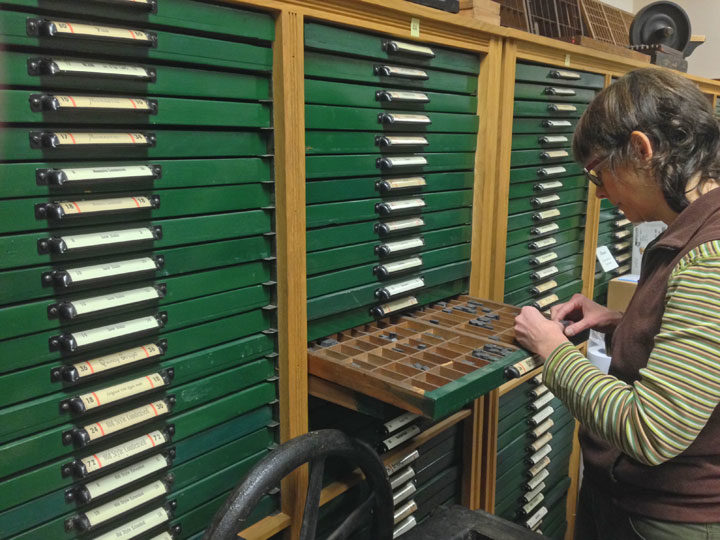
I shot this photo of Jessica typesetting at the Thorniley Collection of Type last year, where she and I were asked to help inventory and appraise the collection (a dream-job moment that I promise to tell you about sometime!).
And then today I came across this short documentary, about the very last edition of the New York Times that was printed from linotype. The year was 1978, and the newspaper was mothballing all its hot-type equipment in order to adopt the brand new, cutting-edge, cold-type technology of phototypesetting. (Phototypesetting was in turn mothballed about 15 years later, when desktop publishing—design software, computer fonts, etc.—hit the mainstream.) If you’re at all interested in printing and have a half hour, I highly recommend the film, as it’s fascinating.
I loved seeing my professional ancestors at work in the film, but I had to laugh, because it struck me that my own career has been a bit, well, backwards.
I got my BFA in the early aughts; much of my design coursework focused on current print technology: design software, digital typography, etc. (Though of course, I was ornery and insisted on including hand-lettering, which was deeply unpopular at the time, in almost everything I did.)
My first industry job, however, was a throwback: I was a production designer doing paste-up at an offset printer that still did phototypesetting. This wasn’t all that long ago: by then that technology was a total dinosaur. At the time they were one of the last presses in the whole country still relying on those processes. The video above demonstrates the paste-up process, but basically the job description is what it sounds like. We took little bits of printed text and photos and, using razor blades and hot wax, pasted them onto a collaged layout that was then photographed and turned into a printing plate. I got to spend my days in a quiet room lit only by light tables, with three other girls who were as introverted as I. I can still smell the wax whenever I think of it—I loved that job, and I loved that smell.
A year or so later I got a job as a graphic designer at a firm, so I guess in that sense I went “forward” in time. But that same month I also got into letterpress printing—proof that my personal tastes were still decidedly cattywampus. I basically did what the printers at the New York Times did in reverse order, trading my cold-type skills in for hand-set hot metal.
And now, while I still keep a finger in both the letterpress (thanks to my collaboration with Jessica) and digital pies, overall I’ve kind of moved backwards in time again. Now I mostly spend my days with the really old-school equipment of paintbrushes and pencils.
And that’s just fine with me. Who says progress has to go only in one direction?
January 11th, 2016
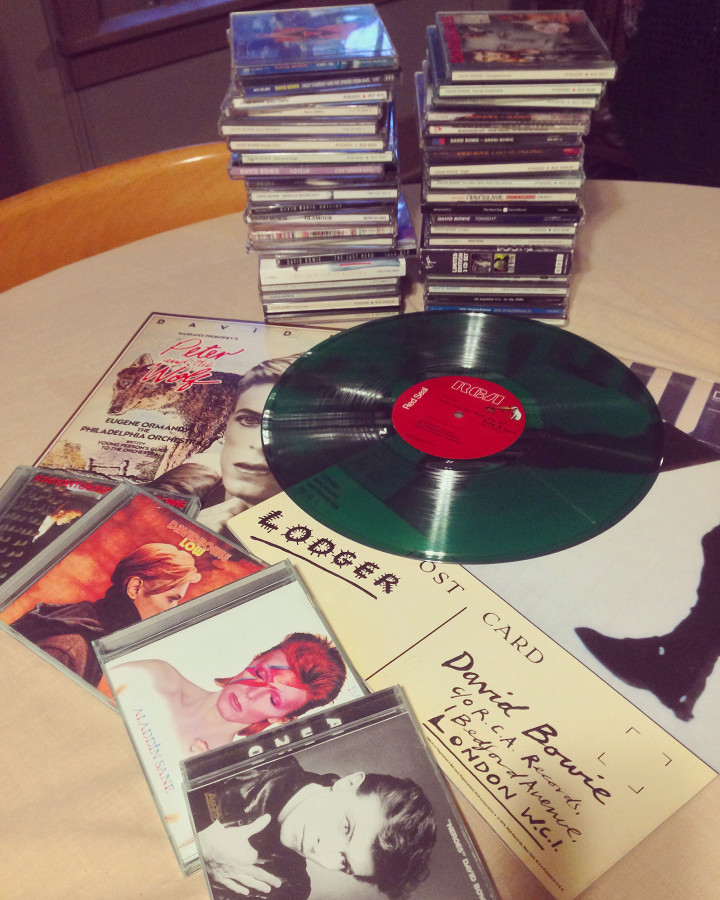
It’s a tradition in my family that when a beloved musician dies, we play their entire back catalog of records in chronological order. I grew up on David Bowie as a kid, and then started feverishly collecting albums almost 20 years ago. By the time I’d amassed pretty much everything he’d ever done, I started joking that when his day came, it’d take me a month to play it all. I’m sorry that that day is already here.
I don’t usually write or post these days about the music I love, because taste is so personal and so subjective. But music is a huge part of my life, and I’ve loved Bowie’s music better and longer than anything else.

And more than that, Bowie has had an enormous influence on me as a visual artist—and I’m not talking about the fan-girl comic-book concert reviews I used to draw for the RISD newspaper, circa 2002 (and I think they only let me do that because my friends were the editors).
What I mean is that Bowie was a huge cultural force, a tastemaker—and I delved into his work at the time when I was forming my own tastes and just beginning to make my own responses to my culture.
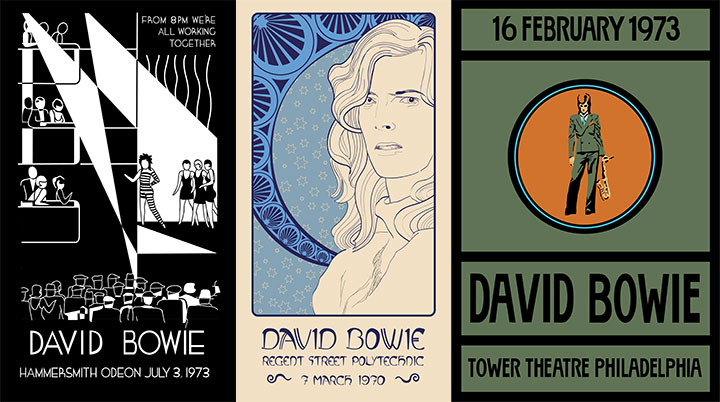
I hesitate to show you these, because most of my student work makes me cringe, but these were part of a series of fake concert posters (of real, historical concerts) I did when I was just starting to do formal lettering work. The lettering is neither her nor there, but it was Bowie’s ever-changing alter egos that inspired me to use different historical periods as the inspiration for each poster. Bowie himself was heavily influenced by history and different cultural traditions—much of it of the non-musical variety—from Kabuki theatre to current events to French mimes to dystopian novelists to Picasso paintings to couture apparel designers, and everything in between. I remember this fact blowing my mind at the time, and it encouraged me to seek inspiration for my work away from my own field and contemporaries. That’s still the primary way I work, and I owe that to him.
The other thing Bowie taught me was not to be afraid to reinvent myself, to change direction and explore something new or totally different. He taught me that it’s possible to create many different types of things, in a wide range of styles that might bear little resemblance to one another, and still come away with a cohesive body of work. As a cultural omnivore who learned from the best of them, that makes perfect sense to me. Yet we still live in a world that largely expects artists to pick one medium, one genre, one style, one “signature” thing and stick with it forever and ever, amen. To reject that notion and follow one’s own path, wherever it might lead, takes a lot of bravery and faith in oneself (and one’s audience!). Bowie’s instincts were unparalleled. He knew how to be broad and deep all at once—he could change a thousand times and never come across as a flake. Instead, he added a new and exotic ingredient to every concoction, until he became one hell of a master chef. If even the smallest fraction of that bravery and instinct might rub off on me, I’ll count myself luckier than I can say.
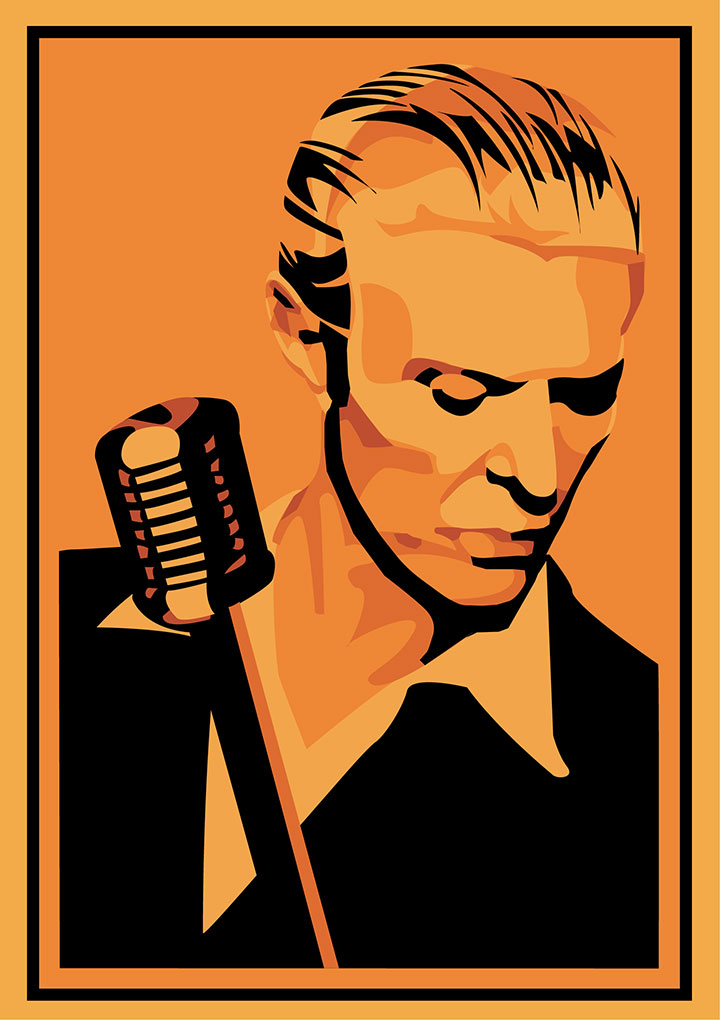
The things we love are a part of who we are and what we contribute to the world ourselves. And sometimes, if we’re lucky, our influences come full circle and bring the things we make in contact with that which inspires us. I got to have a short conversation with David Bowie once, over a decade ago, because of one of those fake posters I designed. I brought this one, printed at a huge size, to a show where I had a front-row seat. During a lull I held it up, and he said nice things to me and asked if I had a request. I told him, and he launched into a 20-minute rendition of “Station to Station.” When it was over, he asked if the rendition was to my liking—I responded with a curtsy, and he laughed and said, “Good curtsy! Nobody curtsies anymore!”
All my friends and family know I’m a huge Bowie fan, and have been emailing and texting me all day about him. My brother sent me the setlist of a mix tape of favorite Bowie songs I made him as a teenager. The sequence of songs still holds up well today, I think, and suddenly it seems like the perfect sendoff. Here they are, with just one small change:
1. Sorrow
2. Fantastic Voyage
3. Rock n’ Roll with Me
4. Panic in Detroit
5. It’s No Game
6. Time
7. The Man Who Sold the World
8. DJ
9. Queen Bitch
10. All the Madmen
11. Beauty & The Beast
12. Sound & Vision
13. Andy Warhol
14. Moonage Daydream
15. Boys Keep Swinging
16. Ashes to Ashes
17. After All
18. Drive-in Saturday
Raising a glass to Major Tom, to Ziggy, to Aladdin Sane, to Halloween Jack, to the Thin White Duke, to the Blackstar, wherever you are now. You were, are, and will forever be my favorite—and my first influence. Cheers.
March 6th, 2010
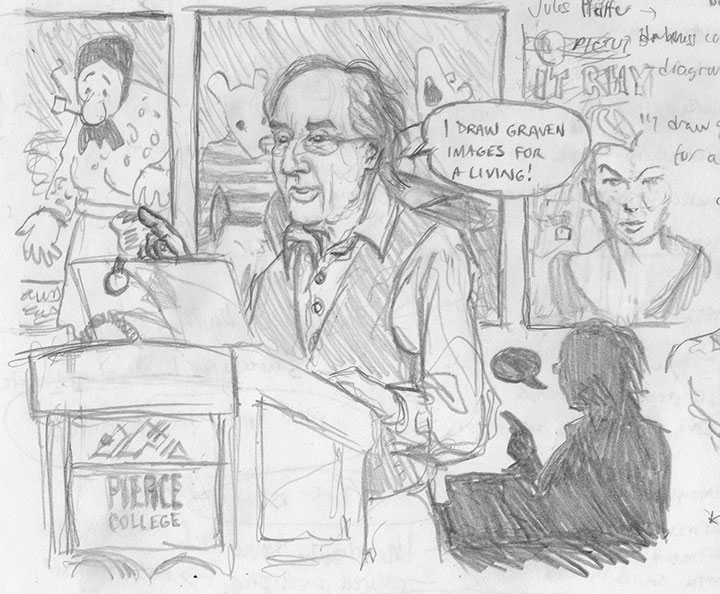
The other night I went to a talk by comics artist Art Spiegelman, and as usual, brought one of my trusty sketchbooks with me. Since comics and I go way back, and I’m a big Spiegelman fan, I think I got a little carried away with the doodles accompanying my lecture notes. I was a little abashed when the people next to me noticed and commented; all I could say was, “I do this a lot—it helps me remember.”
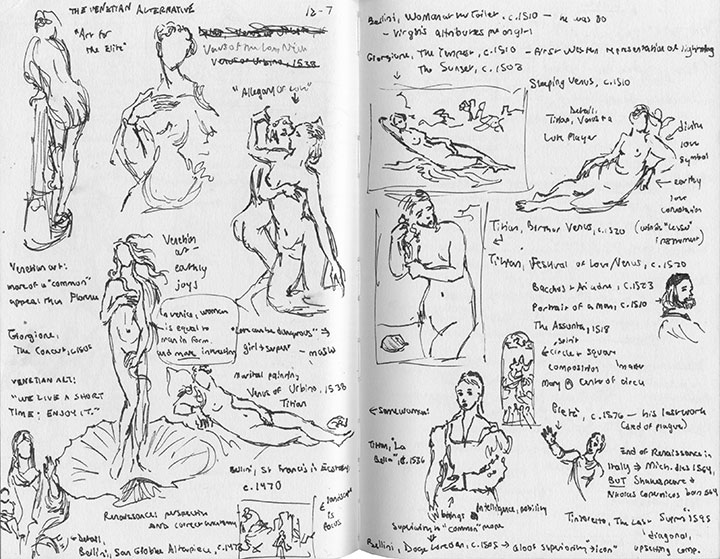
I’ve always been an obsessive note-taker, but I discovered in college that adding sketches to my notes went a long way towards my good grades in art history (this must have been the “Naked Ladies of the 15th and 16th Centuries” lecture or something).
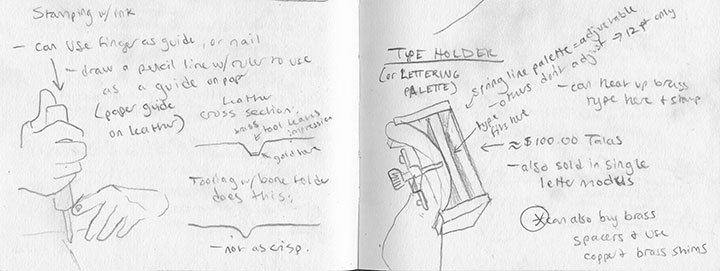
Then when I fell in with the book arts, drawn diagrams were a godsend for remembering complicated equipment and technical processes.
By the time I graduated, the habit was ingrained. I found not only that drawing was an excellent memory trigger, but also helped me focus on the moment at hand.
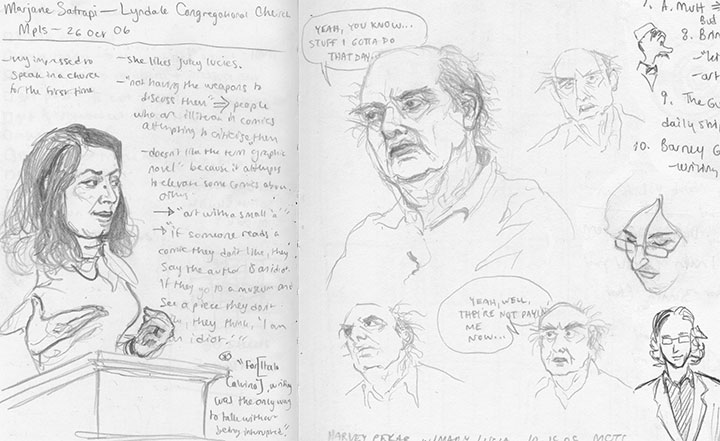
The comments on my Spiegelman doodle reminded me that I had a funny habit of drawing comic artists and writers (from the left, Marjane Satrapi, Harvey Pekar, David Mazzucchelli)—and often portraying them as comic-book characters themselves. As I dug through something on the order of fifteen sketchbooks to find my grumpy Pekar sketches, I unearthed scores of these things, from all manner of locations and events:
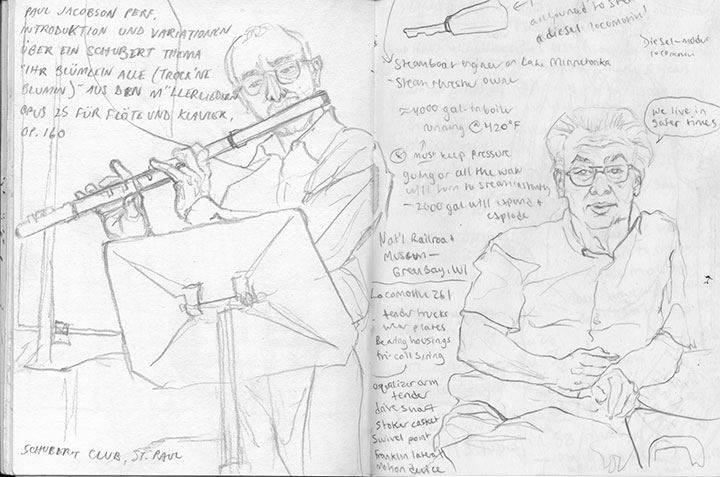
classes, performances and lectures;

public transit and airports—
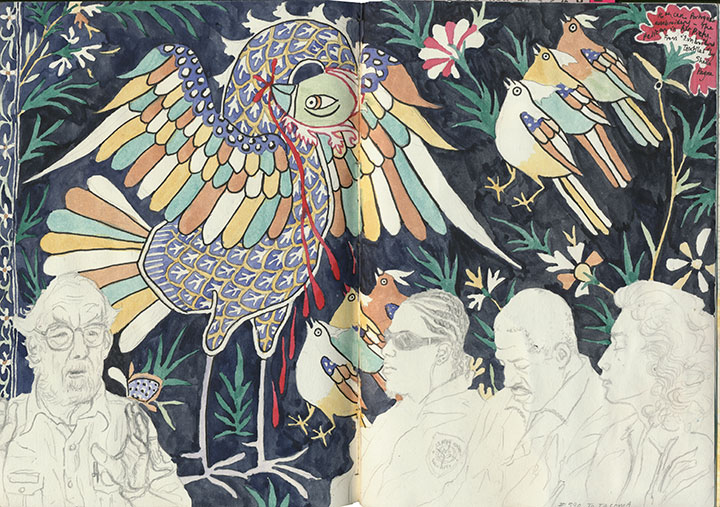
—among other things—
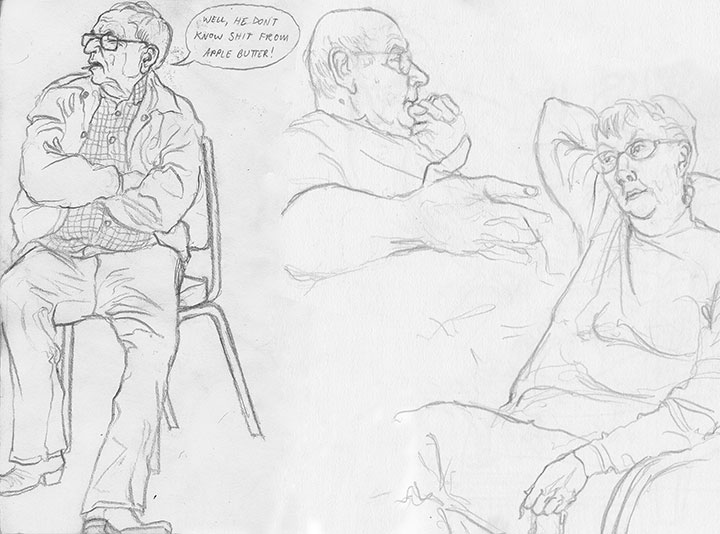
family gatherings (yes, I quoted the above verbatim; that’s the Tailor’s uncle, and he’s comedic gold);

work meetings;
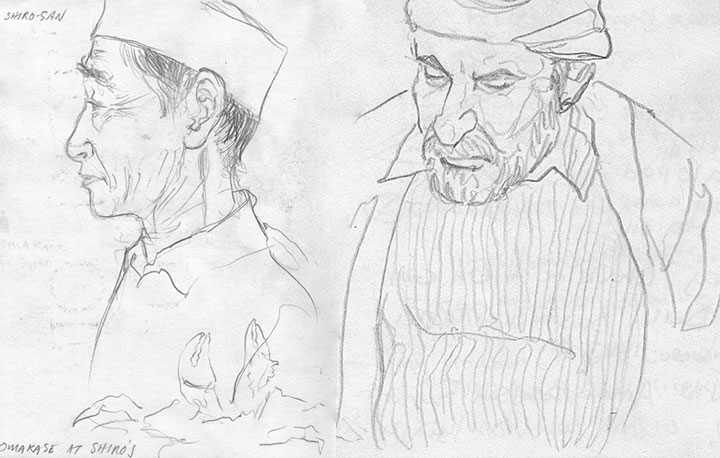
restaurants, coffee shops;

wedding receptions;
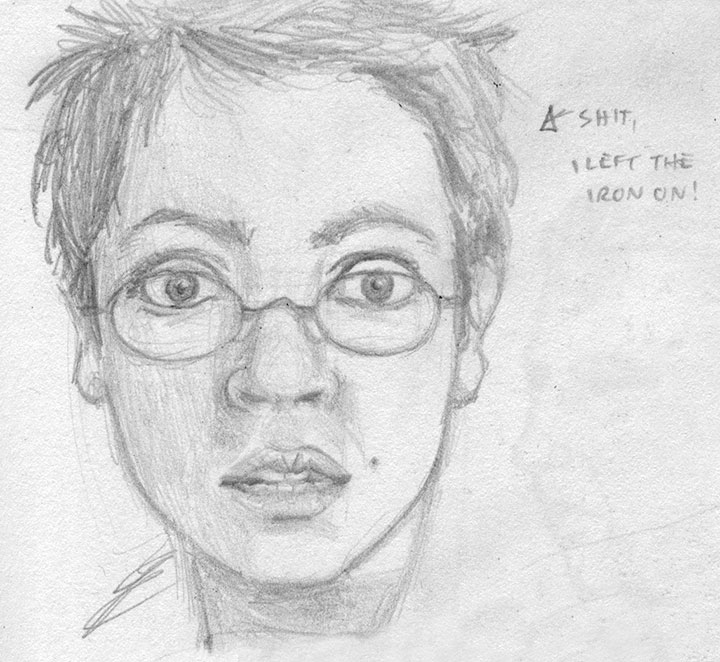
and even my own mirror, when I’m working alone (that one’s an oldie from college).
I draw when I’m trying to document an event, when I’m nervous, when I encounter a particularly unusual face, when I’m telling a story of an odd person I saw that day, when I want to preserve a loved one, and even when I’m not really aware of it—I found plenty of sketches that I had no memory of making.
Maybe there’s some psychological disorder that lists obsessive and semi-conscious sketching as a symptom, but this is one compulsion I’d like to hold on to. I know I spend more time drawing the speaker than taking actual notes, but if I remember the content just as well, I suppose it all comes out in the wash. Besides, I can’t possibly be the only one who does this, right?
Right?

![Chandler O'Leary [logo]](https://chandleroleary.com/wp-content/themes/chandleroleary/images/logo.png)















